The Blue Grosbeak (Passerina caerulea) is a small, migratory songbird that belongs to the Cardinalidae family. It is known for its striking appearance, with the males displaying vibrant blue plumage and the females having a more subdued brown coloration. Here are some key facts about the Blue Grosbeak:
Habitat: Blue Grosbeaks are found in North and Central America. During the breeding season, they can be spotted in the southern United States, Mexico, and parts of Central America. They inhabit open woodlands, thickets, brushy areas, and edges of fields.
Physical Characteristics: Male Blue Grosbeaks have deep blue plumage on their head, back, wings, and tail, with rusty brown or cinnamon-colored wingbars and chestnut-brown underparts. They have a thick, conical bill, which is characteristic of grosbeaks. Females are primarily light brown or grayish-brown with paler underparts and a slight bluish tint on the wings and tail.
Diet: Blue Grosbeaks primarily feed on insects, including grasshoppers, beetles, and caterpillars. They also consume seeds, berries, and fruits, especially during the non-breeding season.
Breeding: During the breeding season, male Blue Grosbeaks sing from prominent perches to establish territories and attract females. Their song is a rich, melodious warble. Nests are typically built in shrubs or low trees, constructed by the female using grass, twigs, and other plant materials. The female lays 3-5 eggs, which she incubates for about two weeks. Both parents contribute to feeding the chicks after they hatch.
Migration: Blue Grosbeaks are neotropical migrants, which means they undertake long-distance seasonal movements. They spend the breeding season in North America and migrate to southern Mexico, Central America, and northern South America for the winter.
Conservation Status: Blue Grosbeaks are generally not considered threatened and have a stable population. However, habitat loss due to agriculture, urbanization, and land development can negatively impact their numbers in some areas.
Blue Grosbeaks are highly valued by birdwatchers and nature enthusiasts for their vibrant plumage and melodic songs. If you're fortunate enough to spot one, they are a delightful addition to any birding experience.


Comments
Post a Comment